
What Are Macronutrients & How Do You Count Them?
PART I
If you are involved in the health or fitness community, chances are you have heard of the term “counting macros”. Counting your macronutrient intake can be beneficial in many ways. It can help promote weight loss or weight gain and can help you achieve your specific goals. Keep in mind that everyone is different and what works for you may not work for someone else. In order to be able to count your macronutrients, you first must understand what macronutrients are.
Macronutrients are substances required in relatively large amounts in the human diet. They are important in the human diet because they are the fuel source for the body. The three types of macronutrients are carbohydrates, fats, and proteins.
Carbohydrates
Carbohydrates are the most important source of fuel for the body. Carbohydrates consist of foods including sugars, starches, and cellulose. Carbohydrates are absorbed by the body and then converted into glucose, or blood sugar, which the body uses for energy in cells, tissues, and organs. Carbohydrates contain 4 calories per gram. The recommended intake of carbohydrates is 45% – 65% of total daily calories. There are two types of carbohydrates: 1) simple carbohydrates and 2) complex carbohydrates.
Simple carbohydrates are also called simple sugars. They are broken down quickly by the body and used as energy. Simple carbohydrates are found in foods such as fruits, vegetables, milk, and milk products. They are also found in candy, table sugar, syrups, and soft drinks.
Complex carbohydrates are made up of long chains of simple sugars. They are broken down over time in the body and are used as energy. Complex carbohydrates are found in foods such as breads, beans, rice, pastas, and starchy vegetables. Most carbohydrate consumption should come from complex carbohydrates because they offer more nutritional value.
Fats
Fat is also essential to the human body as a source of fuel, however, too much fat can hurt the human body. Fat is a nutrient that the human body consumes through the diet. It is absorbed in the small intestine and stored for later use as energy. Fats help the human body absorb vitamins and help to insulate and protect vital organs. The recommended intake of fat is 20% – 35% of total daily calories. Fats contain 9 calories per gram. There are three types of fats: 1) saturated fats, 2) unsaturated fats, and 3) trans fats.
Saturated fats are fat molecules that have no double bonds between carbon molecules because they are saturated with hydrogen molecules. Saturated fats are typically solid at room temperature and come from animal sources. Saturated fats include fatty beef, butter, lard, cream, and cheese. They are typically considered unhealthy because they increase the amount of bad cholesterol in the body.
Unsaturated fats are fat molecules that have more than one unsaturated carbon bond in the molecule, this is also called a double bond. Unsaturated fats are typically liquid at room temperature and come from plant sources. Unsaturated fats include olive oils and canola oils. They are found in foods such as avocados and almonds. These are considered good fats because they do not increase the amount of bad cholesterol in the body.
Trans fats are fats that have been hydrogenated. This means they have been modified by adding hydrogen to them to make them more solid at room temperature and have a longer shelf life. Trans fats are found in fried foods and margarine. They are considered very unhealthy because they increase bad cholesterol in the body and decrease good cholesterol in the body.
Proteins
Proteins are highly complex molecules consisting of long chains of amino acids. Proteins are essential to the body because they do most of the work in cells and are required for the structure, function, and regulation of the body’s tissues and organs. Proteins are broken down and stored in the liver for future use by the body after consumption. If the body becomes depleted of stored carbohydrates and fats, protein may serve as the body’s source of fuel. Proteins contain 4 calories per gram. The recommended intake of proteins is 10% – 35% of total daily calories. There are three types of proteins: 1) complete proteins, 2) incomplete proteins, and 3) complementary proteins.
Complete proteins are proteins that contain all essential amino acids (amino acids that can only be supplied by eating food). All animal sources such as meat, fish, eggs, milk, and cheese are complete protein sources. Soy plant products are also a source of complete protein.
Incomplete proteins are proteins that lack one or more essential amino acids. Often, incomplete proteins are plant sources. Sources such as beans, legumes, nut butters, and some grains are all considered incomplete proteins.
Complementary proteins are proteins of two or more incomplete proteins that when eaten together, they provide adequate amounts of essential amino acids. Sources such as beans and rice or peanut butter and bread are considered complementary proteins.
Okay, I know that was probably a lot of information, but get familiar with it. Now that you are aware of what macronutrients are, stay tuned for part II which will cover how exactly to calculate your unique macronutrients.
Allyssa Catalano has been with Olympia Fitness + Performance in Cranston, RI since August of 2019. She is a recent graduate of Edinboro University of Pennsylvania with a B.S. in Health & Human Performance. She has a passion for fitness, as well as nutrition guidance and wants to help people achieve their specific and unique goals.

